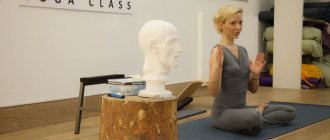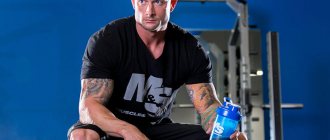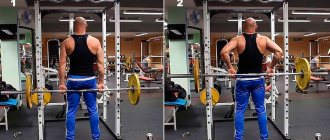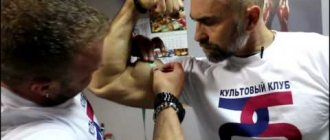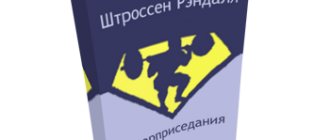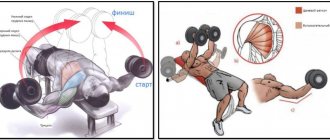Execution option
Only your own weight is used for loading. You need to lie on the floor and place your arms at right angles, palms up. The load will be distributed on them in order to keep the body in an even position. Close your legs and lift them up so that your heels point to the ceiling. At the same time, pull in your stomach.
Next, performing the “Pendulum” exercise is not difficult. As you exhale, lower your closed legs, either to the right or to the left, then inhale and return to the starting position. The arms, upper body and head should not be lifted from the support. Do not try to speed up the pace of execution, as this may affect efficiency. If possible, in the process of lowering your legs to the floor, you should do this slowly so that the tension on the muscles increases.
Beginner athletes can do several repetitions in the “Pendulum” exercise, but after a while increase their number. This is a classic implementation.
Execution technique
Isolated practice involves controlling the biomechanics of movements and focusing on the target muscles. The pendulum in the classic version is performed at the end or at the beginning of the training while lying on the floor, which does not create excessive stress on the spine. Principle:
- In a lying position, your hands are placed in line with your shoulders.
- With the abdomen pulled in, the limbs are raised vertically with the heels towards the ceiling.
- At a slow pace, straight legs are alternately lowered left and right, trying to touch the side surfaces of the floor.
- At the same time, the back, arms, and head are motionless throughout the entire set.
- At first, to make it easier .
Option with fitball
To make it more difficult , a fitball is clamped between the feet or the legs are held at an obtuse angle so that the straight abdomen is included in the process.
Option with elastic band
Sometimes they make a loop from a rubber band, put it on both ankles and stretch it when bending over. An exercise of increased coordination complexity is designed for advanced athletes. All practices start with 1 minute for each leg and work up to 3.
Load with tape
This version of the exercise differs from the previous one in that here the load falls on the hips and buttocks, making them elastic and pumped. The “Pendulum” exercise in different styles helps to work out different muscle groups depending on where the load is concentrated.
You need to take a straight stance. At the same time, stand with both feet on the tape and pull the other end to your chest. Tighten your legs as much as possible and start swinging them to the sides, while stretching the band. This exercise “Pendulum with legs” works well on the muscles of the lower extremities, and you can choose the load yourself (this depends on the density of the tape). Thirty repetitions should be done on each leg. If this is included in the program, then over time you can increase the number of approaches.
Tilts to the side
This exercise targets the external obliques. With good training with additional weights, they become noticeable, but for this you will need to go on a diet to remove the excess layer of fat (if any).
Attention! Bendovers by themselves do not burn belly fat. Without a diet, you will only increase your waist if you lean on this exercise, because the muscles will grow, but the thickness of the fat layer will remain unchanged.
- The legs are spaced shoulder-width apart, the hands are on the belt or one on the belt and the other behind the head.
- Shoulders are straightened, hips are fixed, the lower back does not bend.
- Bend to the right, perform 10-15 repetitions. The tilt is carried out with a tense press.
- Perform 10-15 repetitions on the other side.
If bending is difficult, you can do it with slightly bent legs.
The exercise cycle begins with 10-15 repetitions of bending, 3 sets each. Over time, their number can be gradually increased. If it is necessary to increase the load, bending to the sides is performed with dumbbells in your hands.
© Mihai Blanaru — stock.adobe.com
Additional load
The use of weights during exercise helps create the necessary tone for muscle development and lactic acid production. The exercise will be especially useful for girls who want to make their body slim and tighten their legs.
Standard weights for exercise are kettlebells, dumbbells, and barbells. If it is not possible to use loads of this type, you can use special weights that are attached to the body in the form of a belt or special pads.
This exercise helps to work out the abdominal muscles and at the same time has a good effect on your figure. To perform this, you need to stand with your feet shoulder-width apart, straighten your body and keep your head straight. Take dumbbells in your hands and do alternate bendings.
There is no need to strive to perform as many repetitions as possible, the main thing here is quality, so you need to choose a slow pace and try to bend lower. The “Pendulum” exercise for the waist will be effective in combination with other loads on the abdominal muscles.
Side Press Exercises
There is a wide range of exercises to work the oblique muscles. Of course, you shouldn’t use everything at once in one workout. Choose 3-4, when performed, you feel the oblique muscles working.
Side crunches lying on your side
This exercise is very easy to perform. Therefore, if you have never worked your abs, especially your oblique muscles, then it is best to start with lateral crunches. To perform it, no equipment is needed. It is enough to purchase a fitness mat to make it more comfortable to lie on the floor. This exercise allows you to work the oblique muscles in isolation. In this case, the load on the back muscles is minimal.
Performance:
- We will consider the exercise when performed on the right side.
- Place a fitness mat on the floor. Sit on it lying on your right side.
- Bend your knees to a right angle of 90°
- Extend your right hand and place it on your thigh.
- Bend your left arm at the elbow and place your palm on the back of your head.
- Exhale and begin to bend your right side, trying to bring your left elbow closer to your thigh.
- At the peak point, hold for 1-2 seconds, allowing the oblique muscles to work statically. And while inhaling, return to the starting position.
https://youtu.be/DyOsmZZK_nI
When performing, the main task is to feel how the oblique muscles work. Don't pull yourself with your hand towards your hip. Flexion occurs only due to contraction of the lateral abdominal muscles. You should not make sudden movements. We work at a medium or slow pace. We concentrate on contracting and stretching the muscles. It is possible to add weights when performing these crunches. But it's better not to do this. Since lifting weights can affect the appearance of your waist.
Russian twist
This exercise is more complex. And in addition to the lateral ones, it also loads the rectus abdominis muscle. But this does not make its effectiveness any less. It can be performed either without weight or using weights. To do this, use a dumbbell or a barbell disc. But, as mentioned earlier, you should not chase weight. The main task is concentrated work on the oblique muscles.
Performance:
- We sit on the floor. The legs are slightly bent at the knee joint, the feet are on the floor.
- The back is straight, the body is slightly laid back.
- The arms are bent and clasped in front of the chest.
- Before you begin. Secure your hips, pelvis and shoulders. Movement should occur only in the waist area.
- As you exhale, we turn to the left side, trying to contract the side muscles as much as possible.
- Then we begin to inhale and at the same time, turn to the right side. And at the end of the turn we exhale.
https://youtu.be/P9BuZD-nQF4
We try to turn not due to inertia. It is not the weight that controls the movement, but us through the contraction of the abdominal muscles. We work at an average pace. We try to feel the work of the oblique abdominal muscles. During rotation, the pelvis should remain in place. No movements are allowed in it. In order to complicate the exercise, you can not only use additional weights. Just lift your feet off the floor and lift them up. So oblique, you will still have to work in statics, acting as stabilizers.
Bicycle exercise with rotation
This exercise is classified as light. But in practice it turns out that not everyone can cope with it. Because we need to control several things at once. First, leg movement. They don't have to do all the work alone. Our main goal is to load the oblique and rectus abdominis muscles. Therefore, the legs should be adducted by contracting the abdominal muscles. Secondly, rotation. That is, along with the adduction of the leg, we must rotate in its direction with the opposite side. At the same time, maintaining control over the abdominal muscles. Third, body stabilization. If we do not control its position, the execution can turn into simple swinging. It is very important to control all these points. Or the exercise may not reach its full potential. And your time will be wasted.
Performance:
- Place a mat on the floor and lie on your back.
- Tighten your rectus abdominis muscle. To do this, pull in your stomach and slightly round your back.
- The buttocks should be pressed.
- Bend your arms and place your palms on the back of your head.
- The legs are straightened and the heels are on the floor.
- As you exhale, bend one of your legs and pull it towards your stomach. At the same time, we turn and pull the opposite shoulder towards the knee.
- At this time, the second leg remains straight and at the same time we keep it suspended.
- While inhaling, we return to the starting position.
- As you exhale, do the same on the other leg.
- We alternate sides like this the legal number of times.
There is no need to pull your head towards your leg with your hands. This can damage your neck. The movement occurs due to the work of the oblique muscles. We try to work at full amplitude. Ideally, you should try to touch your knee with your elbow. Movements should be slow and controlled. The pace is medium or slow. If this movement is difficult for you, you should start with a simpler option. To do this, we lie down on the floor. Bend your leg and place one on top of the other. And in the same way, we reach out with the opposite shoulder towards her.
Exercise "Pendulum"
The classic version of this exercise is performed while lying on the floor. It can be easily performed by athletes of any level of training. This exercise specifically loads the lateral abdominal muscles. What makes it as effective as possible. If, when performing, you feel discomfort in the lumbar region, then bend your legs at the knee joint.
Performance:
- We lie down on the floor. We place our arms to the sides, legs together.
- The pelvis, shoulder blades and lower back are pressed. We raise straight (or bent for back pain) legs up until they become perpendicular to the floor.
- As you exhale, we begin to lower our legs to one side until our feet touch the floor.
- Next, we inhale and return to the starting position, and repeat the same in the other direction.
Do not hurry. The movement should occur due to the work of the oblique muscles. If you want to make the exercise more difficult, then place the ball between your feet or hang from a horizontal bar. When performing the pendulum exercise, you don’t have to worry that your waist will become wide.
Exercise "Lumberjack"
This is a complex movement that allows you to work all the abdominal muscles with an emphasis on the obliques. In this case, the back and shoulders are involved in the exercise. They call it that because the movement resembles the work of a woodcutter cutting down a tree trunk with an ax. It can be performed with or without weight. The best thing for this purpose is a crossover exercise machine or a rubber expander.
Performance:
- Lift the crossover block to the very top. Install a rope or D-shaped handle.
- We stand sideways to the crossover. We grasp the handle with both hands. We place our feet shoulder-width apart. For greater stability, you can bend them slightly at the knees.
- As you exhale, rotate your body toward the opposite hip. At the same time, we lower our hands and pull the handle behind us.
- Pause briefly at the bottom. And while inhaling, return to the starting position.
You can also do the lumberjack exercise from the lower block. The execution will be almost the same, only in reverse order. We pull the handle from the hip to the opposite shoulder, while making a rotational movement in the body. If you do not have access to a crossover, then you can perform the exercise with a dumbbell. We just take it in our hands and do the same movements as described above.
Side plank
This exercise is very different from the previous ones. In it, we do not strain the abs isometrically (without movement). That is, we hold the maximum voltage in it for a certain amount of time. This will allow you to tighten your abdominal muscles and make your waist much smaller. You can perform this exercise both in the gym and at home.
Performance:
- We take the emphasis while lying down, as with the classic PLANK.
- Next, we turn to one side, transferring the weight to the forearm and foot, which rest on the floor.
- The free hand can be raised up, placed behind the head and extended along the body.
- The body should not sag, especially in the pelvic area.
- We strain our abdominal muscles and hold it in this position for 10-15 seconds.
- Afterwards, we move the body weight to the other forearm and repeat the same thing.
When performing the plank, do not hold your breath. Your entire body should remain aligned throughout the entire exercise. If it is difficult to stand in this position, you can simplify the exercise a little. To do this, bend your lower leg at the knee and rest it on the floor.
Training the side muscles will help improve your figure. Don't forget your abs are the showcase of your body. The central part, the development of which should come first. But for some reason in the modern world they devote the least time to it. We are not talking about everyday training. A few intense workouts per week are enough to see results. If you find exercises difficult, start with easier versions. Do the plank on your knees, the bicycle with your legs crossed, and so on. This way you can constantly progress and achieve great results.
Good luck to everyone in your training!
Similar articles:
Inverted "Pendulum"
To perform this, you need to stand with your feet wider than your shoulders and bend your body, while your back should not be rounded, you need to keep it straight. The “Pendulum” exercise with bends can be performed without additional load, since the main goal is to tone the body and circulate blood throughout the body.
By performing frequent movements, the lateral muscles of the thighs are well tightened. If you also do a leg press with this exercise, you can tighten the inner thighs well.
Stand in a stance, bend your legs slightly at the knees, move one limb to the side, then return to the starting position and move the other leg to the side. Speed is important here, so the more actively the load is performed, the more effective the result will be.
The recommended norm for beginners is 30 times for each leg. Experienced athletes can perform the same number of repetitions, but with several approaches to increase the dynamics of the effect on the body. You can perform the inverted Pendulum with other variations of this exercise in the same program.
Forward bends
Here the load goes more on the muscles of the rectus abdominis muscle, as well as on the buttocks and lower back. This exercise strengthens the spine and promotes stretching.
- The feet are shoulder-width apart, and there is a deflection in the lower back.
- You should lean forward with tense abs, trying to keep your back as straight as possible.
- Your fingers should touch the floor. If this is not possible, then you do not need to round your back too much. It is better to slightly bend your knees and stretch to the highest possible level, getting closer to the floor day by day. Flexibility and stretching in the lower back will appear with regular training, and over time you will be able to reach the floor with your hands without bending your legs.
- The body must be returned to its original position using the muscles of the buttocks. To do this, push your heels into the floor. The muscles of the lower back should be relaxed.
Load for men
Men can also perform this exercise, but in a modified form. For this purpose, a bar is used in the hall. The “Pendulum” exercise with bending to the side with weights helps to work not only the abdominal muscles, but also the muscles of the arms.
You need to fix one end of the bar, put a load on the other and raise it in front of you to the level of your head. The left leg should be the supporting leg, the right leg should be pushed back and rested on the heel. With a sharp movement of your arms, which do not bend at the elbows, throw the weight of the bar in the opposite direction, while twisting your abdominal muscles.
After some time, return to the starting position and perform the load in the other direction. Do this alternating until tension is felt on the sides. You need to work at a fast pace. Even if the speed drops as the weight approaches the hip, try to resume the pace when twisting in the other direction. This is a dynamic exercise, so it needs to be performed in several approaches.
Let's define what a pendulum is.
In fact, pendulums are different, but they all have one thing in common - uniform swinging with a mandatory center at one fixed point.
Look around carefully: there is no static in the world. Everything – both living and inanimate – vibrates. And vibration is nothing more than the same pendulum. When combined, different vibrations form waves. And from these waves, twisted in a spiral, our entire world is formed.
Man is no exception; he also vibrates both as a whole and in each organ separately. And for health it is important that there are no obstacles to these vibrations that distort their harmony.
In Slavic gymnastics there is a whole set of exercises, united by the common name “Pendulums” or “Balagayar”.
Having deviated from the main position under the influence of the applied force, the pendulum weight, located at the free, unattached end of the rod, tends to return to the initial position. If the rod had not been weighted with a weight, then this would have happened. But in our case, an energy impulse is formed, or as V.E. calls it. Meshalkin, “tension”, due to which the weight by inertia passes through the starting point and deflects in the opposite direction.
Read more: How to properly give an injection in the buttock
In Balagayari the same principle applies, only at the muscle level. The exercises dynamically involve antagonistic muscles: flexors and extensors, while the strength of the flexor is equal to the strength of the extensor (therefore, we do not apply any additional effort). Thanks to this, the muscles are not overloaded, because. only 30% of energy is used.
It is very important to perform Pendulums in a state of alertness (from English alert - vigilance).
Let's speculate a little.
A description of this state can be found in Osho, K. Castaneda. This is a state of complete flexible relaxation in a strong community with internal composure, vigilance and readiness to instantly respond to any external influence on a subconscious level. Being alert, we instantly and adequately respond to any changes in the external environment without unnecessary waste of vital energy, and the saved energy can be used for other needs, for example, to maintain or restore health.
Usually, such a state is natural for a hunter who does not know behind which bush or corner he can meet an unexpected animal. It is known to athletes and military personnel because... At any moment, a situation is possible that requires an instant solution. This is the alert sensitivity of all systems with complete relaxation of the body.
A person performs all movements thanks to the interaction of the skeletal system and muscles.
The bones are connected by joints that allow them to bend, extend, and even rotate. Several bones connected by joints form body parts (for example: arm, leg); in biomechanics these connections are called biokinematic or biomechanical chains. And the entire human body is one harmonious biokinematic chain.
The joints connecting the bones into a chain play the role of inertial nodes and at the same time are frame points that bring together the bone frame and carry out cross-tensions among themselves.
It is very important to create and maintain the image of the frame and tensions corresponding to the exercise being performed in order to obtain the maximum and fastest effect.
Vladislav Eduardovich Meshalkin recommends starting to master pendulums in pairs. I didn’t have such an opportunity, so I studied without an assistant. It seemed to me that it was no more difficult than with two people. The main thing is to be able to feel the tension created by each specific exercise. And for this purpose, each exercise has a name that helps to create an image of a certain physical object.
If everything is done correctly, the feeling you get is so comfortable that you simply don’t want to stop.
Read more: Dips for triceps technique How to pump up triceps on parallel bars
We will get acquainted with the varieties of “Pendulums” in the following articles. Now let’s learn how to enter the state necessary to perform them correctly. A preparatory exercise will help with this.
Coach tips
Experts advise performing the load several times a week in modified versions to achieve the desired result. Depending on the type of stance you choose and the use of additional loads, you can work different muscle groups.
This load is included in different types of programs, ranging from strength training to fat-burning exercises. To increase efficiency, you need to perform a load after doing a cardio warm-up, this increases the chances of working different muscles and at the same time getting a good result.
You cannot do the “Pendulum” with a load right away, without experience. Excess weight can damage soft tissue and lead to muscle tears. To avoid this, in the initial stages you need to perform the exercise without load.
For beginner athletes, it is better to avoid doing exercises in several approaches; this will help work out a certain type of muscle, but the rest of the muscles will not be worked out, which will reduce the effectiveness of the training.
Contraindications and precautions
As such, tilts in each direction have no contraindications. Perhaps caution is needed in case of problems with the lower back, since a considerable load is placed on it. Please note that you need to be careful with scales. Resist the temptation to immediately grab a heavy dumbbell. This may pose a risk to the spine. In addition, heavy weight training is aimed primarily at muscle growth, so it is not suitable for you if you want to lose weight. It is better for women to use weights up to 3-5 kg, and for men - up to 7 kg. It is better to have less weight, but more repetitions.
Additionally, consider the following precautions :
- If you bend with a bend in the lower back and relax your stomach, the lumbar region will receive the load, and not the muscles that we need. This can cause a number of injuries, including a hernia.
- When turning the body during execution, abrasion of the intervertebral discs and pinching of nerve endings is possible.
- If you train with heavy weights, your muscles will increase in size, which may increase your waist width.
Errors and omissions
The “Pendulum” exercise has a positive effect on the press, but you need to adhere to the execution technique; without this, the load can even be harmful. Often athletes perform the Pendulum too quickly or by bending their legs and arms. This reduces efficiency and the exercise no longer brings the desired benefit.
You cannot combine the “Pendulum” with pumping the abs; this can cause overwork and muscle strain. It is necessary to alternate work on this group and change the loads on the upper and lower body for a high-quality result. Regular exercise will help make your figure beautiful and toned.
Pendulum: exercise features
Today we want to talk about the pendulum exercise, which can use a large number of muscles - the pendulum. It can be useful not only for bodybuilders, but also for fighters. This movement is aimed at developing explosive strength, coordination, and can also improve the athlete’s endurance. In addition, a significant load falls on the stabilizer muscles.
However, this is not the only advantage of the pendulum. By performing the exercise, you can load almost all the muscles of the body, including the legs and even the trapezius. However, the maximum load falls on the shoulder girdle and oblique abdominal muscles.
LiveInternetLiveInternet
Sunday, August 16, 2020 07:17 + in quote book Practical exercises for skills in working with a pendulum We are starting practical exercises now, and this will be your debut in radiesthesia. Don't be discouraged if you make a few mistakes at first, don't be nervous. If you fail, relax and repeat the exercise a little later. If, as often happens. You will be successful from the very beginning, do not get drunk on it, do not do more exercises than you should, and do not forget that fatigue is the main reason for failure. Exercise 1: electric battery. Take the battery and cover or completely wrap it in opaque paper (white or gray is best). Turn the wrapped battery over several times so that it is not clear what position it is in. Place it in front of you on black paper and use a pendulum to find the position of its poles. To do this, you place a pendulum at one of its ends, give it a slight oscillatory motion (neutral) and ask yourself the question: “Which pole of the battery is on this side?” According to the mental contract you have made with yourself, the pendulum will soon spin to the right or left, thus indicating whether a given pole is positive or negative. Comment. At the time of performing the exercise, clearly and clearly ask yourself the question, since the clarity and precision of the answer depends on this. Exercise 2: geometric shapes. Cut out geometric shapes from the table. 1 and put each of them in an envelope, except for one of the circles. Place the envelopes in front of you on a black tablecloth, mixing them thoroughly before doing so. Place this extra circle and place a pendulum over it, allowing it to rotate in any direction. Then place the pendulum over each envelope in turn, asking yourself the question: “Is the circle in this envelope?” When the pendulum is above the envelope with the circle, it will rotate in the same direction as above the open circle (“witness”). Above the remaining envelopes, the pendulum will rotate in a different direction, twitch, or stop altogether. The rotation must be precise. Exercise 3: colors. Repeat the same exercise using colored paper. Cut the leaves into 2 parts; one of them will be hidden in an envelope, the other will serve as a “witness”. Look for what color is in each envelope. However, be sure to discharge the pendulum before each use of a new color of paper. So that the following exercises are a success. You must be confident in yourself. Ask one of your friends to help you with the following exercises. This person must definitely trust you and radiesthesia, or, in extreme cases, be indifferent and not excited. Criticism, doubts, ironic remarks will be quite enough for you to make a mistake. Exercise 4: pictures. Show your colleague a sheet of pictures, such as animals. Ask him to choose an element from this drawing and think intensely about it. “Tune” the pendulum by allowing it to rotate over your colleague’s right palm, then move it to each picture in turn. When the pendulum hits the selected element, it (the pendulum) will rotate in the same way as above the palm. The pendulum will perform different movements over each new element. Attention! Beware of self-hypnosis. Try to create absolute emptiness in your consciousness, allowing the pendulum to act independently. If you know the colleague you are working with well, you will probably have the wrong thoughts, the feeling that you know in advance which element he has chosen (according to his tastes and character), and in 99 cases out of 100 you will be wrong, since the choice, made by your colleague will almost always be accidental. Exercise 5: geometry. Give your colleague one of the circles from the table. 1 (exercise 2) and ask him to clasp it in his fist, and then show you both fists. “Tune” the pendulum to the “witness circle” and look for the fist in which the circle is located. Exercise 6: colors. Place different pieces of colored paper on a black tablecloth (from exercise 3). Then, as in ex. 4, ask your colleague to take a sample of one color in his hand, hiding the rest from you. “Tune” the pendulum over your colleague’s palm and determine which color he chose. Thus, you can come up with many similar exercises for yourself. I advise you to repeat the learned exercises several times before moving on to the next ones.
Series of messages “Pendulum”:
Part 1 - How to choose a pendulum Part 2 - PRACTICAL EXERCISES FOR WORKING WITH A PENDULUM Part 3 - PENDULUM Part 4 - About the pendulum, its role in the development of magic and its influence on life and destiny ... Part 6 - a pendulum for quality control products Part 7 - DEVELOPMENT OF INTUITION WITH THE HELP OF A PENDULUM Part 8 - Pendulum
Cited 1 time
Like share
0
Like
- I liked the post
- Quoted
- 0
Saved
- Add to quote book
- 0
Save to links
Liked
0
A three-minute set of exercises to relax muscles and relax the spine
Bartsok gymnastics course for the spine
Maintaining a healthy spine is impossible without regularly releasing excess tension from its muscles. Then, under normal loads, the spine can remain healthy throughout your life. In this case, you can use relaxing exercises for the spine from this complex in any quantity at the time you need.
For osteochondrosis and scoliosis, it is better to start regular therapeutic exercises for the spine with this set of unloading exercises, which, once mastered, will take only 1 to 3 minutes. The complex is recommended if you have pain in the spine, as exercises for the spine with osteochondrosis or scoliosis, with heavy physical or mental work during or immediately after work, as well as in case of great fatigue before bedtime.
These therapeutic exercises for the spine can be performed while sitting, but it is better to stand with your feet shoulder-width apart.
Observation of belly breathing.
Calmly, slowly, fill your stomach with air and also calmly exhale it. Mentally observe how your stomach smoothly expands as you inhale and flattens as you exhale. You can close your eyes. Take 3-4 slow and smooth breaths in and out, observing how your spine responds to your breathing.
An instant relaxation spinal stretch exercise.
Turn your attention to the top of your head and imagine that a strong thread is attached to it, which is being pulled upward with force. Don't stretch upward by straining. Just clearly imagine that you are being pulled up by the top of your head. This image is a command to your nervous system to relax the muscles of the spine. She must obey and relax her muscles, and then the spine itself will stretch upward, to its natural position. With some skill, the entire action should take no more than a second. This Golden Thread spinal stretching exercise is described in detail in Good Posture Training. The “Golden Thread” is at the same time the main exercise for straightening posture, a technique for instant relaxation of the body, and a therapeutic exercise for the spine with osteochondrosis.
An exercise to stretch the spine and relax it by observing your breathing.
As you continue to breathe calmly through your belly, try to make the sensation of inhalation and exhalation through all parts of your spine as clear as possible.
Feel the air of inhalation moving down along the spine. It should feel like a tidal wave is stroking your vertebrae one by one and separating, pulling them apart from each other. Then the spine itself will begin to change its shape and relax.
Now pay attention to the exhalation. The wave of air you exhale moving along the spine from bottom to top will lift each vertebra, lengthening and straightening the spine. This observation of exhalation quickly relaxes and lengthens the spine, therefore it can be considered both an effective exercise for the spine with osteochondrosis and an exercise for stretching the spine.
Observing your breathing as a whole, you will easily find that inhalation pulls the vertebrae down, and exhalation pulls them up towards the ceiling. With breathing, the spine contracts and stretches like a spring, and observing the breath makes this spring lighter and more mobile. For osteochondrosis and scoliosis, it is better to do this exercise for the spine more often. If you are doing therapeutic exercises for the spine, if there is pain in the spine, focus your attention on the movement of inhalation and exhalation air separately along the problem area of the spine, and then the pain will soon subside.
Directives to eliminate unnecessary stress.
To maintain a healthy spine, as well as as a therapeutic exercise for the spine, you can use Alexander's directives. When used frequently, these guidelines are effective in eliminating chronic tension even in the deep-lying muscles of the spine, making them the most important exercises for the spine in osteochondrosis.
Mentally, without making conscious movements, invite your head to move forward and up, and your neck to move back; invite your shoulders to drop down and move back; invite your back to expand to the sides and lengthen; invite your hips and pelvis to expand to the sides; Invite your feet to expand and lengthen and your toes to relax.
These are mental orders or requests from your mind addressed to your body. The nervous system must carry them out and give appropriate orders to the parts of the body. You can learn more about this in the training “Use of the Alexander technique for the prevention and treatment of spinal osteochondrosis.”
Pendulum.
This exercise for the spine can be done both sitting and standing.
Keeping your feet still and your back straight, lean your body (or upper body, including your head if you're sitting) forward and back. If you are standing, your feet should remain motionless while your body moves; if you are sitting, your tailbone should remain motionless. Your body will move from your ankles (or from your tailbone if you are sitting) like a pendulum or metronome. This pendulum swing should be, if possible, smooth and not too fast: it is better to move forward while exhaling, and moving backward while inhaling. Pay special attention to the fact that as the body moves, the head and shoulders move with it, that is, neither the neck nor shoulders are tense, and the back tilts rather than bends. Your pendulum movement should be easy. It will become even easier if, at the same time, you use the “Golden Thread” spinal stretching exercise.
While moving, mentally examine your body from top to bottom, looking for muscle tensions, and shift the tensions found lower: from the back of the head to the neck, then from the neck to the shoulders, from the shoulders to the back, down the back lower and lower, then even lower down the legs to ankles. This exercise can be useful for a healthy spine against fatigue or stress, and as an exercise for the spine with osteochondrosis.
source
Pendulum exercise for the spine
We knew that no one would choose a surgical method to correct posture
But many would not refuse massage and physical therapy. And we have both of these methods in one lesson.
Study and come fix your back
Spinal trainer “Healing pendulum” post pinned
Svetlana Korzhova
A few words about this screenshot of WhatsApp correspondence.
Pavel was brought to me by my wife, as usual
You, our dear boys, love to bring your pain to the extreme.
Show in full... At the start, there was wild pain in the back, radiating to the leg, to the point that the person even ate while standing. That's how much it hurt. A bunch of painkillers, constant blockades (injections, hernia sufferers will understand).
We started working. Once a week On the pendulum. Plus homework - after each meeting I gave an exercise.
And after 10 lessons, voila!
THE PAIN IS GONE. AT ALL. The spine has become more flexible!! Almost scoliotic distortions were removed!!
That's how he is. Exercise machine HEALING PENDULUM. and me too, of course
Conclusion - there is a way out, don’t suffer from pain!!
Spinal trainer “Healing pendulum” post pinned
Svetlana Korzhova
Today our Fitness Studio Step welcomed guests from Germany!!
These are the distances people travel to get to our HEALING PENDULUM simulator. Show in full…
Do you live in Dmitrov, and you always have no time, are always far away?
I challenge your bad backs!! Write if anyone is bothered by back pain!!
PS watch the video and practice your English
Spinal trainer “Healing pendulum” post pinned
Fitness studio Step in Dmitrov
Pavel was brought to me by my wife, as usual
Our dear boys love to bring their pain to the extreme. Show in full... At the start there was severe pain in the back, radiating to the leg, to the point that the person even ate while standing. That's how much it hurt! A bunch of painkillers, constant blockades (injections, hernia sufferers will understand).
We started working. Once a week on the pendulum. Plus - homework, after each meeting I gave an exercise.
And after 10 classes - voila, THE PAIN IS GONE COMPLETELY. The spine has become more flexible! Almost scoliotic distortions have been removed!
Here it is, the HEALING PENDULUM simulator, and me, of course
Conclusion
If your back hurts, there is a way out, don’t suffer from pain!
Come and try it! Moreover, a trial lesson costs a symbolic 300 rubles. Sign up via the link: vk.me/fitness.shag
Spinal trainer “Healing pendulum” post pinned
DIVNORECHYE eco-complex in Sochi, Nizhnyaya Khobza village
Spinal trainer “Healing pendulum” post pinned
The spine is called the “pillar of life” because of its enormous influence on the health of all human systems and organs.
Each of the individual segments of the spine, the vertebrae, protects a specific part of the spinal cord and shares with its section of the spinal cord the responsibility for the functioning of a specific organ. Show in full…
The first cervical vertebra of the cervical spine is associated with the blood supply to the head, pituitary gland, scalp, brain, inner and middle ear, and sympathetic nervous system. When it is displaced, dizziness, headaches, migraines, nervousness, insomnia, chronic runny nose occur, intracranial pressure increases, amnesia (complete or partial memory loss), and a feeling of chronic fatigue are possible.
The second cervical vertebra is connected to the eyes and ocular nerves, auditory nerves and ear cavities, mastoid processes in the temporal bone, tongue, and forehead. If its position is violated, allergies, visual impairment, including strabismus, ear pain, and fainting occur.
The third cervical vertebra is connected to the cheeks, external auricle, facial bones, and trigeminal nerve. The consequences of its displacement will be neuralgia, neuritis, acne, eczema.
The fourth cervical vertebra is connected to the nose, lips, mouth and the eustachian tube located in the ear. Hay fever, catarrh, hearing loss and adenoids will be the consequences of disruption of the nerve connections to these parts of the body.
The fifth cervical vertebra is connected to the vocal cords, tonsils and pharynx. Hoarseness, laryngitis, throat diseases, inflammation of the tonsils will be the consequences of a disruption of the connection between the vertebra and these organs.
The sixth cervical vertebra is connected by nerves to the neck muscles, shoulders and tonsils. When it is displaced, rigidity (inflexibility) of the neck muscles, pain in the upper arm, and tonsillitis occur.
The seventh cervical vertebra is connected to the thyroid gland, shoulder bursae, and elbow joints. The consequences of vertebral displacement will be bursitis, colds, and thyroid diseases.
The first vertebra of the thoracic spine is connected to the arms - from the elbow joint to the fingertips, the esophagus and the trachea. When nerve connections are disrupted, bronchial asthma, cough, difficulty breathing, shortness of breath, and pain in the arms occur.
The second thoracic vertebra is connected to the heart (including the heart valves) and the coronary arteries. The consequences of nerve dysfunction will be functional heart disease and some breast diseases.
The third thoracic vertebra is connected to the lungs, bronchial tubes, pleura, and chest. Consequences of violations: bronchitis, pleurisy, pneumonia, influenza.
The fourth thoracic vertebra is connected to the gallbladder and bile ducts. Therefore, gallbladder diseases, jaundice and herpes zoster will be the consequences of infringement of this vertebra.
The fifth thoracic vertebra is connected to the liver, solar plexus, and blood. Liver disease, fever, low blood pressure, anemia, and poor circulation may occur.
The sixth thoracic vertebra is connected to the stomach, and the consequences of disruption of nerve connections will be stomach diseases, indigestion, heartburn, and dyspepsia.
The seventh thoracic vertebra is connected to the pancreas and duodenum. If a nerve is pinched, gastritis and duodenal ulcers may occur.
The eighth thoracic vertebra is connected to the spleen, and when nerve connections become difficult, the body’s resistance to environmental influences is reduced.
The ninth thoracic vertebra is connected to the adrenal glands and adrenal glands. The consequences of disruption of interaction will be allergies and urticaria.
The tenth thoracic vertebra is connected to the kidneys. Its displacement can cause the development of kidney diseases: nephritis, pyelitis (inflammation of the renal pelvis); cause hardening of arterial walls.
The eleventh thoracic vertebra is connected by nerves to the kidneys and ureters, and when it is pinched, skin diseases (acne, pimples, eczema, boils) occur.
Twelfth thoracic vertebra - small intestine, lymphatic system. If nerve connections are disrupted, rheumatism, abdominal pain, and some types of infertility may occur.
The first vertebra of the lumbar spine is connected to the colon and inguinal rings. The consequences of disruption of nerve connections are constipation, colitis, diarrhea, hernia.
The second lumbar vertebra is connected to the appendix, lower abdomen and upper leg. Convulsions, difficulty breathing and acidosis (disturbance of acid-base balance in the body) are a consequence of disruption of nerve connections.
The third lumbar vertebra is connected to the genitals, uterus, bladder, and knees. When a vertebra is displaced, bladder diseases, menstrual disorders (irregular or painful menstruation), urination problems, impotence, and severe knee pain occur.
The fourth lumbar vertebra is connected to the prostate, psoas muscles, and sciatic nerve. The consequences of impaired communication are sciatica, lumbago, difficult, painful or too frequent urination.
The fifth lumbar vertebra is connected to the lower leg, ankles, and feet. When a vertebra or nerve is pinched, blood circulation in the legs is disrupted, the ankles and insteps of the feet become swollen and weakened, and cramps in the calf muscles occur.
The sacral spine is connected to the pelvic bones and buttocks. When the vertebrae are displaced, diseases of the sacroiliac joint occur.
The fused coccygeal vertebrae are connected to the rectum and anus. Hemorrhoids, itching and pain in the coccygeal region are signs of displacement of the coccygeal vertebrae.
"Paul Bragg's Great Encyclopedia of Health"
source



